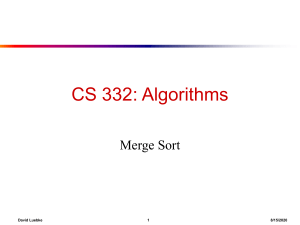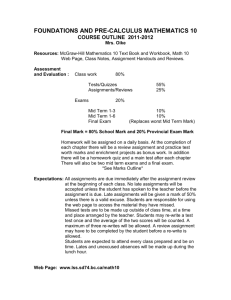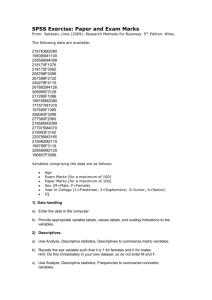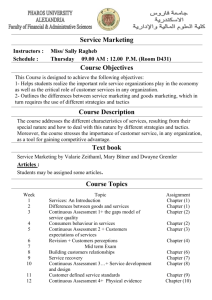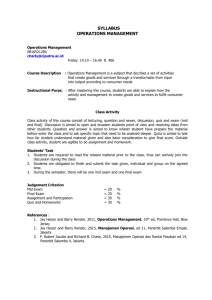CUSTOMER_CODE SMUDE DIVISION_CODE SMUDE
advertisement
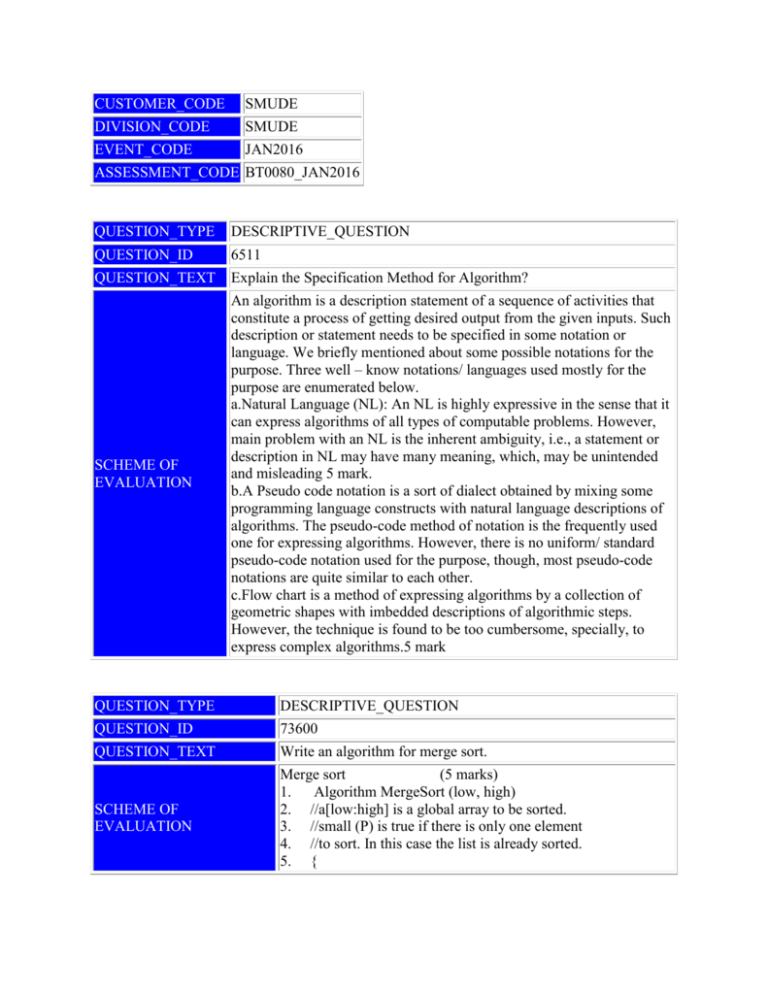
CUSTOMER_CODE
SMUDE
DIVISION_CODE
SMUDE
EVENT_CODE
JAN2016
ASSESSMENT_CODE BT0080_JAN2016
QUESTION_TYPE
DESCRIPTIVE_QUESTION
QUESTION_ID
6511
QUESTION_TEXT
Explain the Specification Method for Algorithm?
SCHEME OF
EVALUATION
An algorithm is a description statement of a sequence of activities that
constitute a process of getting desired output from the given inputs. Such
description or statement needs to be specified in some notation or
language. We briefly mentioned about some possible notations for the
purpose. Three well – know notations/ languages used mostly for the
purpose are enumerated below.
a.Natural Language (NL): An NL is highly expressive in the sense that it
can express algorithms of all types of computable problems. However,
main problem with an NL is the inherent ambiguity, i.e., a statement or
description in NL may have many meaning, which, may be unintended
and misleading 5 mark.
b.A Pseudo code notation is a sort of dialect obtained by mixing some
programming language constructs with natural language descriptions of
algorithms. The pseudo-code method of notation is the frequently used
one for expressing algorithms. However, there is no uniform/ standard
pseudo-code notation used for the purpose, though, most pseudo-code
notations are quite similar to each other.
c.Flow chart is a method of expressing algorithms by a collection of
geometric shapes with imbedded descriptions of algorithmic steps.
However, the technique is found to be too cumbersome, specially, to
express complex algorithms.5 mark
QUESTION_TYPE
DESCRIPTIVE_QUESTION
QUESTION_ID
73600
QUESTION_TEXT
Write an algorithm for merge sort.
SCHEME OF
EVALUATION
Merge sort
(5 marks)
1.
Algorithm MergeSort (low, high)
2. //a[low:high] is a global array to be sorted.
3. //small (P) is true if there is only one element
4. //to sort. In this case the list is already sorted.
5. {
6.
if (low< high > then //If there are more
than one
element
7.
{
8.
//Divide P into sub problems
9.
//Find where to split the set
10.
mid:= [(low+high)/2]
11.
//Solve the sub problems
12.
MergeSort (low,mid);
13.
MergeSort(mid+1, high);
14.
//combine the solutions
15.
Merge(low, mid, high)
16.
}
17. }
Merge
(5 marks)
Algorithm Merge (low, mid, high)
//a{low: high] is a global array containing two sorted
//subsets in a [low: mid} and in a [mid+1 high]. The
//goal is to merge these two sets into a single set residing
//in a [low: high],b[J is an auxiliary global array.
{
h:=low; i:low; j:=mid+1;
while ((h ≤ mid) and (j≤ high)) do
{
If (a[h]≤ a[j]) then
{
b[i] : a[h]; h:—Th+1;
}
Else
{
b[i]:=a[j]; j:=j+ 1;
}
i:i+1;
}
If (h >mid) then
Fork=jto high do
{
b[i]:=a[k]; i:i+ 1;
}
Else
For k:=h to mid do
{
b[i]:=a[k]; i:i+1;
}
For k:=lowto high do
a[k]:=b[k];
}
QUESTION_TYPE
DESCRIPTIVE_QUESTION
QUESTION_ID
125572
QUESTION_TEXT
Prove the theorem “A given connected graph G is a Euler graph if and only if
all the vertices of G are of even degree”.
Proof: Direct part: suppose G is a Euler graph. Then G contains a Euler line.
So there exists a closed walk running through all the edges of G exactly once
……. (5 marks)
SCHEME OF
EVALUATION
Converse: Suppose all the vertices of G are of even degree, now to show that
G is a Euler graph, we have to construct a closed walk starting at an arbitrary
vertex v and running through all the edges of G exactly once …… (5 marks)
QUESTION_TYPE
DESCRIPTIVE_QUESTION
QUESTION_ID
125573
QUESTION_TEXT
Discuss backtracking strategy. Give an algorithm for N-queens
problem.
Backtracking Technique explanation (3 marks)
Algorithm N–Queens problems
Algorithm N Queens (k, n)
{
For I:= 1 to n do
{
If place (k, j) then
SCHEME OF
EVALUATION
{
X[k]:=i;
If (k=n) then write [x[1:n]]
Else Nqueen (k+1, n);
}
}
}
Algorithm place (k, i)
{
for (i:=i) to (k–1) do
if ((x[j]–I or Abs (x[j] = Abs (j–k)))
then return false
return true
}
(7 marks)
QUESTION_TYPE
DESCRIPTIVE_QUESTION
QUESTION_ID
125575
QUESTION_TEXT
Explain Euclid’s Algorithm for finding G.C.D of two Natural Numbers.
SCHEME OF
EVALUATION
i.
ii.
iii.
Divide m by n and let r be the new remainder.
If r = 0, the algorithm terminates and n is the answer otherwise.
(Interchange) let the new value of m be the current value of n and the
new value of n be the current value of r. Go back to step (i)
r must be equal to zero in finite number of steps (i) (ii) and (iii)
QUESTION_TYPE
DESCRIPTIVE_QUESTION
QUESTION_ID
125577
QUESTION_TEXT
Explain the different category of problems.
i.
ii.
iii.
SCHEME OF
EVALUATION
iv.
v.
Problems which cannot even be defined formally
Problems which can be formally defined but cannot be solved by
computational means.
Problems which though theoretical can be solved by computational
means, yet are infeasible.
Problems that are called feasible or theoretically not difficult to solve by
computational means.
Last but probably most interesting class includes large number of
problems, for each of which, it is not known whether it is in P or not in
P.
(2 5 = 10 marks)

